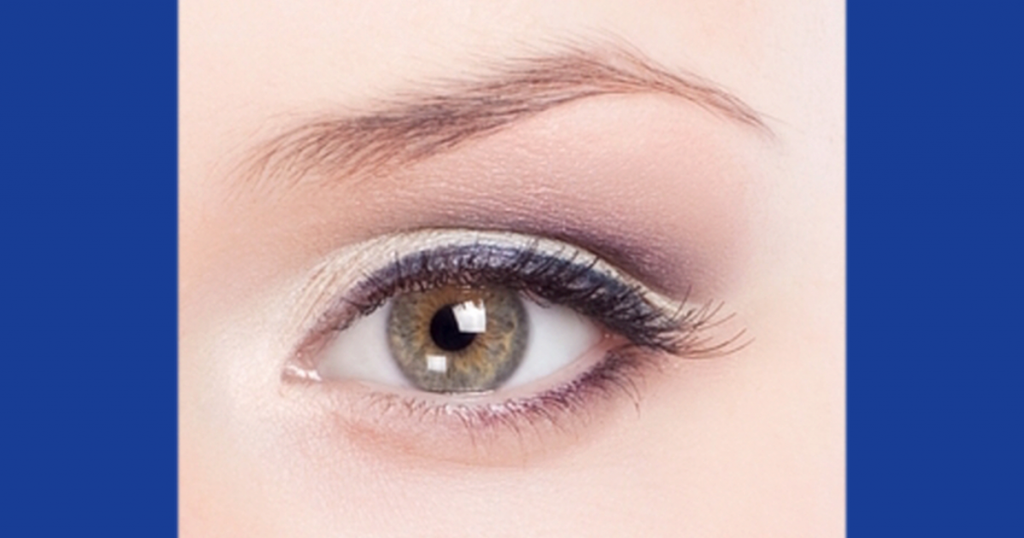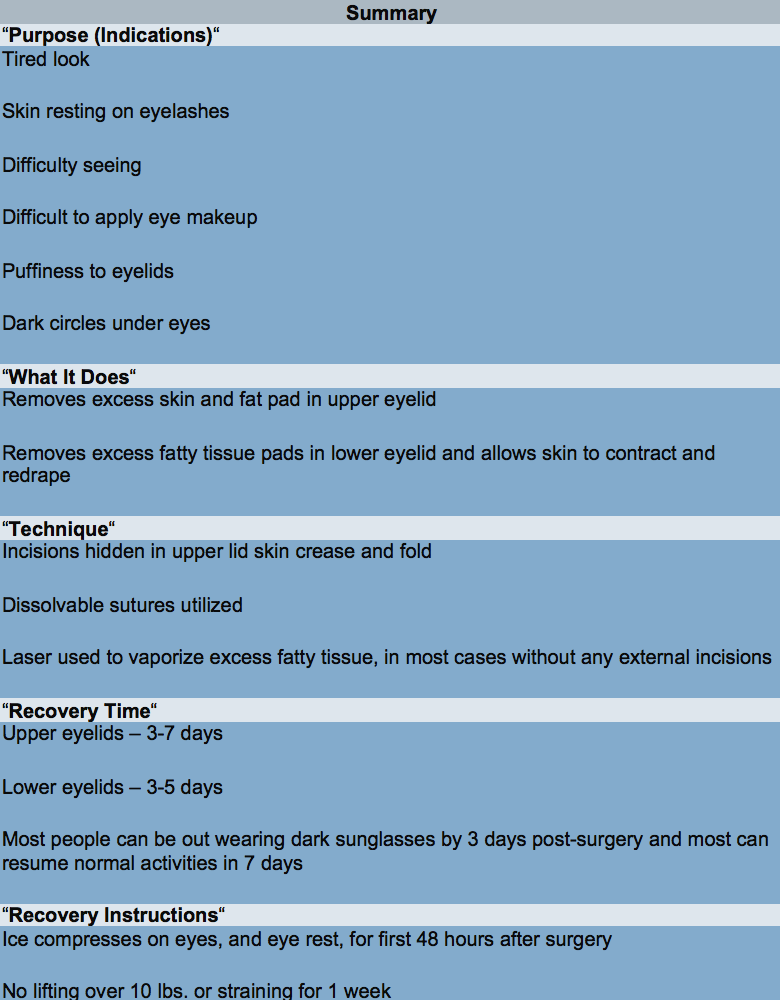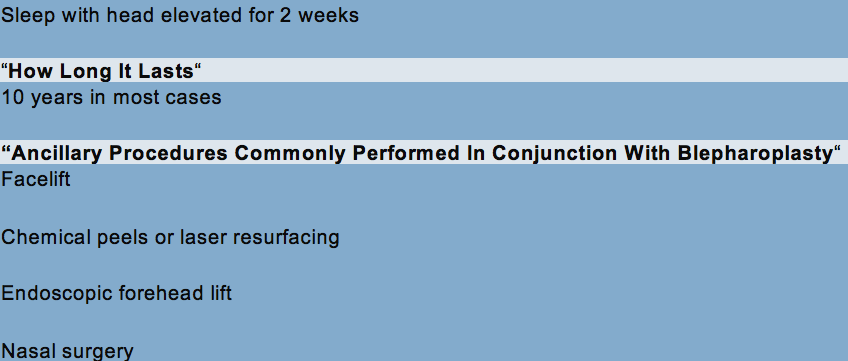
Eyes are one of the first areas to show aging. Some people refer to the eyes as the “windows of the soul.” They are certainly the focal point of the face and increased laxity of skin can portray a tired, sad, or melancholy appearance when in actuality we feel otherwise. Blepharoplasty surgery, or the eyelid tuck as it is sometimes called in layman’s language primarily gives us a more rested appearance by reducing the excess skin and fatty tissue which can develop in both the upper and lower eyelids with aging.
Eyelid surgery is usually performed under twilight anesthesia on an outpatient basis. A special marking pencil is used to mark the upper eyelid crease and calipers are used to engage the amount of excess skin contained in the upper eyelid in a method called a pinch technique. The skin is then removed and excess fatty tissue from the middle (medial) most portion of the eyelid is also removed. In some cases the upper eyelid muscle may be contoured. The incision is closed with dissolvable sutures and/or sutures that run underneath the skin and can be painlessly removed after one week. Within approximately one week the incision conforms to the natural contour of the eye and is hidden in the eyelid fold. Laterally it blends in to the fine eyelid creases in the outer part of our eye.
In the lower eyelid an incision is made several millimeters below the eyelash line and is carried laterally into the skin crease. The skin and muscle are reflected down and three fatty tissue pockets in the lower eyelid are opened and excess fatty tissue is removed. The skin and muscle are then repositioned and excess skin is removed. The incisions are closed with interrupted dissolvable sutures. Frequently special tape is used to support the lower eyelid area for a week after surgery. This helps to reduce the amount of swelling and bruising and allows and increased amount of extra skin to be removed more safely.
If the only problem in the lower eyelids is bagging secondary to excess fatty tissue, the laser can be used, with no external incision. In this case the laser removed the fatty tissue from inside the eyelid with no incision on the outside of the eyelid. If excess fatty tissue has resulted in stretching of the lower eyelid skin, then both fatty tissue and skin need to be removed in the traditional blepharoplasty with an external incision.
Patients commonly will ask how long eyelid surgery lasts. Because the tissue is removed, one will always look better than they would have had they not had the surgery. Unfortunately we continue to age, so there will always be changes in this area. We are fortunate that eyelid changes do not occur as rapidly after surgery as changes in other areas. While some individuals may require repeat surgery, we find that most people, whether they have surgery done at age 30, or at age 50, rarely have to have this procedure repeated. This appears to be due to the fact that the fatty tissues does not recur and that the eye is located within the bony structure and appears to be protected somewhat by the gravitational and environmental effects of aging as contrasted with the cheeks, jowl and neck area which may need tuck up procedures after a facelift.
Various types of chemical peels can be used to remove wrinkling in the eyelid area and provide an additional tightening effect to the skin. These are usually performed 3-4 months after the eyelid surgery. Various types of chemical peels can be used. Each type of peel varies in the degree of wrinkle removal and tightening that is obtained. Some provide an increased lightening effect to the skin in the eyelid area. A new development in recent years has been the use of laser abrasions to resurface or rejuvenate eyelid skin.
Following eyelid surgery an individual needs to sleep with their head elevated approximately 30º for the first two weeks following surgery. They need to refrain from lifting over 5-10 pounds or activities which result in heart rate elevation for the first 7 to 10 days following surgery. This will help to minimize the amount of swelling and bruising. Eyelid incisions are cleansed with hydrogen peroxide soaked Q-tips 4-5 times a day during the first week. The patient can wash over these areas or get in the shower, as long as the shower spray does not directly hit the face. In fact this is encouraged in order to accelerate the wound healing. Makeup can be applied after 7 days. Applying makeup sooner could result in irritation to the incision lines and should be avoided.
Ice water soaked compresses are applied to the eyelid area, every 10 minutes, for the first 48-72 hours following surgery. This is critical in helping to reduce swelling and bruising, decrease discomfort and accelerate wound healing. Ice packs work well, but do not contour into all areas of the eyelid and therefore increased swelling and bruising can result. This problem is eliminated with wash clothes soaked in ice water.
One needs to limit eyelid movement for the first 48 hours after surgery. This means they should keep their eyes closed as much as possible and use the cold compresses. If an individual was reading, watching TV, or doing paperwork immediately following surgery, each time they blink their eye they would be pulling and stretching the incision lines. This obviously will decrease healing and result in more swelling and bruising. During those first 48 hours the patients should have as much eye rest as possible. We would recommend listening to books on tapes, CD’s or listening to the television (but not watching). Approximately 90% of patients find that at the end of one week they can resume their normal activities and have significant improvement in their appearance as compared to before surgery. In 10% in cases there may be some increased swelling and bruising. Even this can usually be camouflaged with makeup.
When transconjunctival blepharoplasty is performed, patients can often return to normal social and work activities within 48 hours. Advances in laser technology allow this surgery to be performed with much less discomfort, bruising and swelling. However this procedure can only be done if there is good elasticity to the lower eyelid skin.


Schedule a Consultation
Communication is not secure. Contacting the practice does not establish a physician/ patient relationship.*